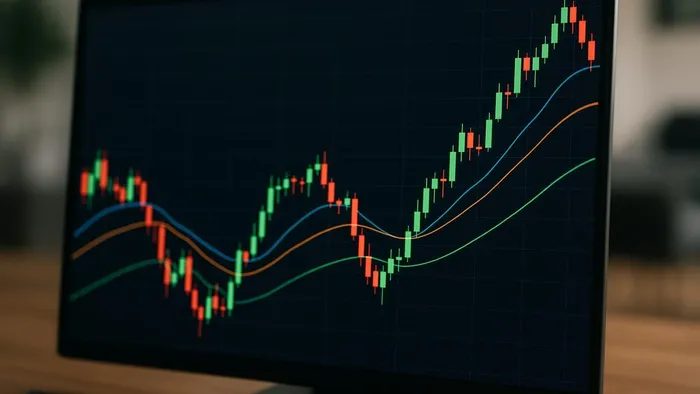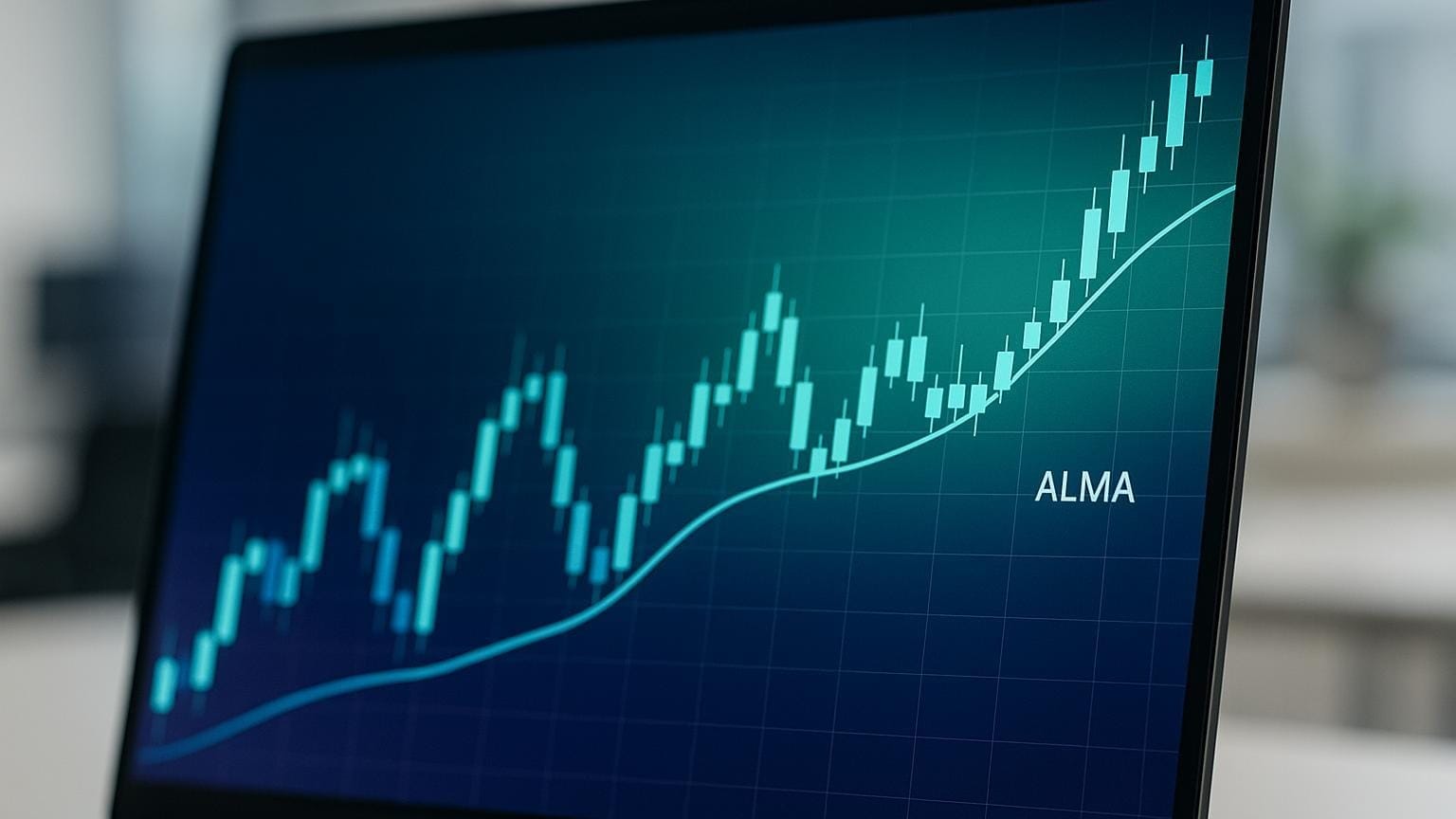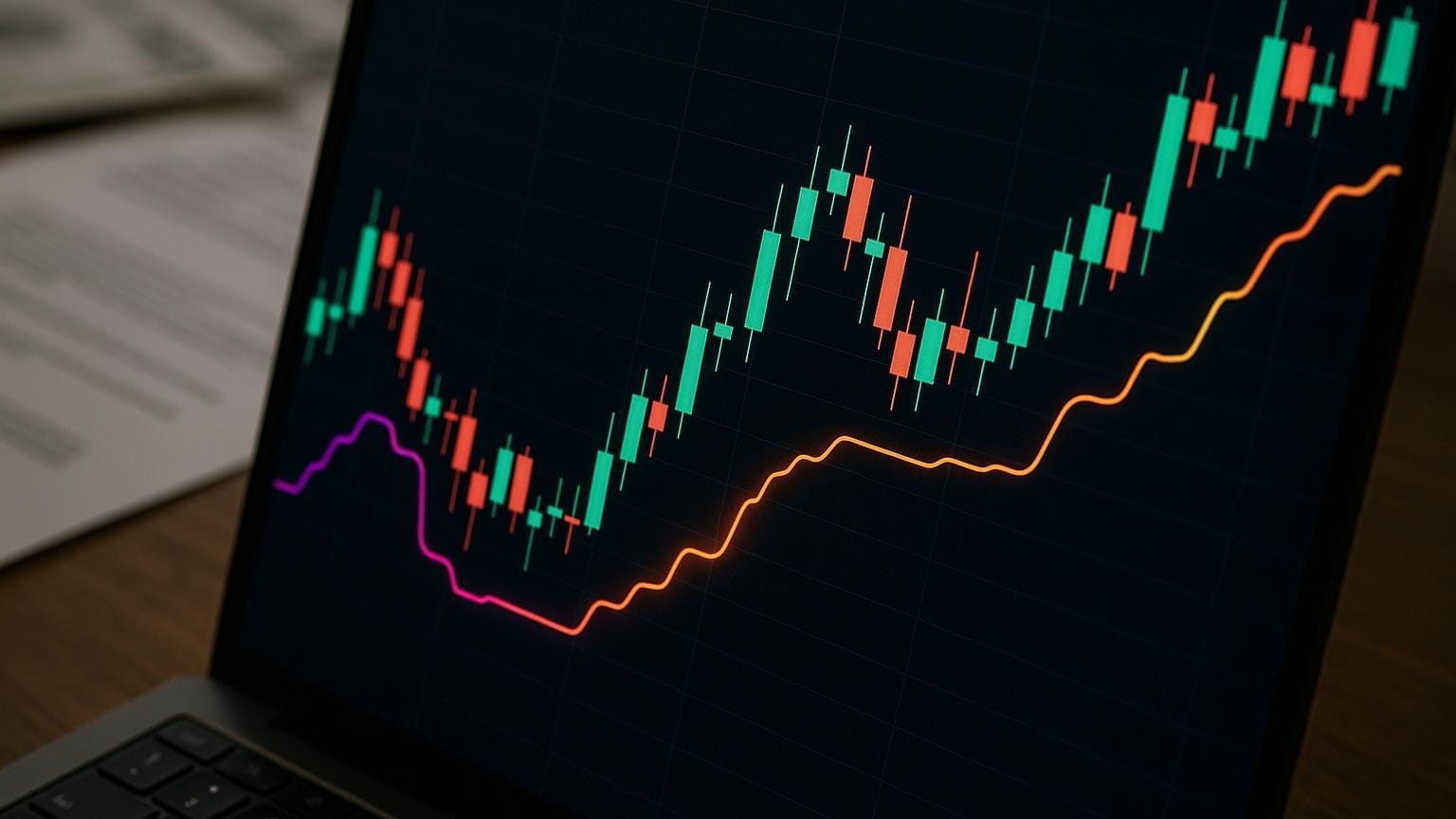Explore the Triple EMA (TEMA) indicator and its advantages in reducing lag and smoothing trends for effective trading strategies.
The Triple Exponential Moving Average (TEMA) is a technical indicator designed to reduce lag and smooth price data, making it easier for traders to identify trends and reversals. By applying exponential smoothing three times, TEMA minimizes delays while staying responsive to price changes. This makes it especially useful for day traders and swing traders in fast-moving markets.
Key Benefits of TEMA:
- Lag Reduction: Reacts faster to price changes compared to simple and exponential moving averages.
- Smooth Trends: Filters out market noise without sacrificing responsiveness.
- Trend Identification: Helps spot trend directions, momentum shifts, and potential reversals.
- Versatility: Works across various assets like stocks, forex, and cryptocurrencies.
How It Works:
- TEMA combines three layers of exponential moving averages (EMA₁, EMA₂, EMA₃) using the formula:
TEMA = 3 × EMA₁ − 3 × EMA₂ + EMA₃. - This calculation reduces lag while maintaining a smooth trend line.
Use Cases:
- Trend Following: Price staying above/below TEMA indicates an uptrend/downtrend.
- Reversal Signals: Price crossing above or below TEMA can signal potential trend changes.
- Short-Term Trading: Ideal for identifying pullbacks and reversals in volatile markets.
Limitations:
- False Signals: Can generate misleading signals in choppy or sideways markets.
- Complexity: Requires more data points and understanding compared to simpler moving averages.
For traders seeking a balance between responsiveness and smoothness, TEMA offers a practical tool for improving entry and exit timing. Pair it with other indicators like volume or MACD for stronger confirmation signals.
TEMA (Triple EMA) Indicator Explained
How to Calculate TEMA
Understanding how TEMA (Triple Exponential Moving Average) is calculated highlights its ability to smooth data while reducing lag. This indicator combines three layers of exponential moving averages (EMAs) using a specific formula that corrects for the delays caused by each smoothing step. Below, we break down the calculation process and provide an example using U.S. formatting.
Step-by-Step TEMA Formula Breakdown
Calculating TEMA involves three main steps: first, calculate the EMA₁ based on closing prices; next, compute EMA₂ using EMA₁ as input; finally, derive EMA₃ from EMA₂.
The formula for TEMA is:
TEMA = 3 × EMA₁ − 3 × EMA₂ + EMA₃
Here’s how it works:
- EMA₁ provides the initial smoothing of price data.
- EMA₂ applies additional smoothing, introducing some lag.
- EMA₃ refines the data further, correcting for the lag and ensuring TEMA closely follows price movements.
How TEMA Differs From Standard Moving Averages
What sets TEMA apart from traditional moving averages is its ability to balance smoothness and responsiveness. A Simple Moving Average (SMA) assigns equal weight to all price points, which can result in considerable lag. An Exponential Moving Average (EMA) improves responsiveness by giving more weight to recent prices. TEMA takes this a step further by layering and correcting EMAs, resulting in a more responsive and accurate tracking of price trends.
Unlike an EMA, which uses data points equal to the specified period, TEMA requires more data points, calculated as (3 × period − 2).
| Indicator | Weighting Method | Lag Level | Data Points Needed |
|---|---|---|---|
| SMA | Equal weighting | High | Period length |
| EMA | Exponential weighting | Moderate | Period length |
| TEMA | Triple EMA with correction | Low | 3 × period − 2 |
Example Calculation Using U.S. Formatting
Let’s calculate a 5-period TEMA using a set of stock prices in U.S. dollars. Assume the following closing prices: $45.25, $46.10, $45.85, $47.20, $46.95, $48.30, $47.75, $49.15, $48.60, $50.25, $49.80, $51.45, $50.90, $52.35.
Since a 5-period TEMA requires 13 data points, this dataset is sufficient. The smoothing factor for a 5-period EMA is 0.3333.
Step 1: Calculate EMA₁.
Start with the first five prices ($45.25 through $46.95). The initial SMA is $46.27. For subsequent prices, use the EMA formula:
EMA₁ = (Close × 0.3333) + (Previous EMA × 0.6667).
By the 14th price ($52.35), let’s assume EMA₁ is $50.86.
Step 2: Calculate EMA₂ using EMA₁ values.
This step further smooths the data, but it also introduces more lag.
Step 3: Calculate EMA₃ using EMA₂ values.
This step refines the data, correcting the lag introduced by the previous layers.
Step 4: Apply the TEMA formula:
TEMA = (3 × $50.86) − (3 × $49.95) + $49.23
= $152.58 − $149.85 + $49.23
= $51.96
The final TEMA value is $51.96, which closely follows the current price of $52.35, showing how TEMA reduces lag compared to a standard EMA.
How to Use TEMA in Trading Strategies
Now that we've covered how to calculate TEMA and its smoothing advantages, let's dive into how it can be applied in trading. TEMA's reduced lag and ability to maintain smooth price action make it a go-to approach for traders seeking early trend identification and timely decision-making. Its responsiveness to price changes gives it an edge over traditional moving averages.
Using TEMA for Trend Identification
TEMA is particularly effective at pinpointing trend direction and strength by analyzing its interaction with price action. For instance:
- When the price stays above a rising TEMA line, it's a clear sign of a strong uptrend.
- Conversely, if the price remains below a falling TEMA, it indicates a downtrend.
The slope of the TEMA line can also reveal momentum. A steep upward slope suggests growing bullish momentum, while a flattening line could hint at a weakening trend.
Price crossing the TEMA line can signal potential trend reversals. For example, when the price moves from below the TEMA to above it, or vice versa, it might indicate a shift in the trend. However, these signals aren't foolproof — it's wise to confirm them with other approaches to avoid getting caught in false breakouts, especially in sideways markets.
To enhance the reliability of these signals, many traders pair TEMA with complementary indicators.
TEMA in Combination with Other Indicators
Pairing TEMA with additional technical approaches can strengthen trading strategies and help filter out misleading signals. For instance:
- Candlestick Patterns: A rising TEMA combined with a bullish engulfing pattern during a retracement can confirm a trend continuation.
- Volume indicators: Use volume to validate TEMA signals. For example, a price crossover on TEMA accompanied by high trading volume is more reliable than one during low-volume periods. Hold onto trades until the price breaks the TEMA in the opposite direction.
- VWMA (Volume-Weighted Moving Average): A popular strategy involves using a 50-period TEMA alongside a 25-period volume-weighted moving average (VWMA). Open positions when the TEMA and VWMA cross in the same direction, and exit when the price breaks the VWMA in the opposite direction. Since VWMA incorporates volume, it often provides stronger exit signals than TEMA alone.
- Modified MACD: Replacing the standard EMA inputs in the MACD with TEMA can reduce lag while retaining the MACD's ability to measure momentum. This adjustment makes MACD signals more responsive and actionable.
These combinations are particularly useful for traders focusing on short-term setups.
Short-Term Trading Benefits of TEMA
Day traders and scalpers often gravitate toward TEMA because of its ability to deliver quick, noise-free signals. Its reduced lag means traders can spot trend changes earlier than they would with traditional moving averages, allowing for precise entries ahead of significant moves.
TEMA is also excellent for identifying pullback reversal points in trending markets. When paired with oscillators, it helps traders pinpoint temporary retracements that provide favorable entry opportunities in the direction of the prevailing trend.
For intraday strategies, using TEMA on shorter timeframes like 5-minute or 15-minute charts can offer a clear sense of market direction. Changes in the TEMA's slope can guide position sizing or adjustments to stop-loss levels as market conditions shift throughout the day.
Finally, TEMA's smoothing properties help traders stay focused on the bigger picture, avoiding overreactions to minor price fluctuations during volatile sessions while keeping sight of the underlying trend.
How to Read TEMA Signals for Market Decisions
Now that we've explored how TEMA is calculated and applied, the next step is learning how to interpret its signals effectively. Properly reading TEMA signals can be the difference between a successful trade and a costly mistake, as it provides timely insights into market trends and potential reversals.
Common TEMA Signal Scenarios
TEMA signals often confirm market movements when specific conditions align. For instance, a bullish crossover occurs when the price moves above an upward-trending TEMA, signaling strong buying momentum. On the flip side, a bearish crossover happens when the price dips below a downward-trending TEMA, indicating selling pressure.
A flattening TEMA or divergence between price and TEMA can hint at potential reversals. For example, when the price forms higher highs but TEMA fails to reach new peaks, it may reveal hidden weakness in the uptrend. Conversely, if the price makes lower lows while TEMA forms higher lows, it could suggest accumulation and a likely upside reversal.
These scenarios highlight how price and TEMA interactions can help traders fine-tune their entry and exit strategies.
Price–TEMA Relationships and Timing Entry/Exit Points
To refine market timing, it’s important to understand the relationship between price and TEMA. The gap between the two can reveal momentum shifts and potential turning points. For example, a sharp move above TEMA might indicate overbought conditions and the possibility of a pullback.
TEMA often acts as a dynamic support or resistance level, making it a useful approach for timing trades. In a strong uptrend, the price frequently pulls back to the TEMA, creating low-risk entry points. Traders can set stop-loss levels just below the TEMA to manage risk. Similarly, in a downtrend, TEMA can act as resistance during brief rallies, offering potential exit opportunities.
Using multiple timeframes can also improve signal accuracy. For instance, a bullish crossover on a shorter timeframe gains more weight if the TEMA on a longer timeframe is also trending upward. This alignment helps filter out false signals and highlights higher-probability setups.
Volume adds another layer of confirmation. High trading volume during crossovers strengthens the validity of TEMA signals and supports sustained price moves. On the other hand, low or declining volume as the price approaches the TEMA may suggest weak conviction, increasing the likelihood of a failed breakout.
TEMA Advantages and Limitations
To make the most of TEMA (Triple Exponential Moving Average), it's important to weigh its strengths against its weaknesses. Like any technical concept, TEMA performs well in certain scenarios but has its challenges in others.
TEMA Strengths
TEMA stands out for its ability to minimize lag, cut through market noise, and adapt to different timeframes, making it a reliable approach for spotting trends. Its triple exponential calculation smooths out minor price swings that often mislead traders using simpler moving averages. This helps reduce the risk of whipsaw trades, which can chip away at profits over time.
One of TEMA's key advantages is its ability to reflect genuine market sentiment. Its smooth line makes it easier to identify significant trend changes while filtering out temporary market noise. In volatile markets, this feature becomes particularly useful, as TEMA helps traders focus on meaningful price movements. However, its sensitivity can also lead to false signals in choppy conditions, which is something to keep in mind.
These strengths make TEMA a powerful component for refining entry and exit strategies, but it’s equally important to understand its limitations.
TEMA Limitations
TEMA's sensitivity, while often an advantage, can work against traders in sideways or choppy markets, where it may generate false signals. This can lead to premature entries or exits, disrupting an otherwise solid strategy.
Another drawback is its complexity. The triple calculation process behind TEMA makes it harder to grasp how the indicator reacts to price movements. This can create challenges during backtesting or when navigating unusual market conditions.
TEMA also struggles in low-volatility environments. When prices move within narrow ranges, the indicator often oscillates around the price, causing more confusion than clarity. In such cases, simpler moving averages might offer more stable reference points.
Additionally, TEMA relies heavily on recent price data. This means sudden price spikes or gaps — often caused by news events or market openings — can skew its signals, even if those movements don’t reflect the broader market sentiment.
Comparison Table: TEMA vs EMA vs SMA
| Feature | TEMA | EMA | SMA |
|---|---|---|---|
| Lag | Lowest | Moderate | Highest |
| Responsiveness | Very High | High | Low |
| Noise Filtering | Excellent | Good | Fair |
| False Signals | Moderate–High | Moderate | Low |
| Trend Clarity | High | Moderate | High |
| Calculation Complexity | High | Low | Very Low |
| Best Market Conditions | Trending, Volatile | Most Conditions | Stable, Clear Trends |
| Whipsaw Risk | Moderate–High | Moderate | Low |
| Learning Curve | Steep | Moderate | Easy |
This table highlights how TEMA compares to other moving averages like EMA (Exponential Moving Average) and SMA (Simple Moving Average). TEMA is ideal for fast-moving markets where quick reactions are crucial, but it comes with a higher risk of false signals. EMA offers a balanced approach with decent responsiveness and simplicity, while SMA prioritizes stability at the expense of delayed signals.
Using TEMA with LuxAlgo’s Trading Tools

LuxAlgo provides TradingView-based tools you can use alongside TEMA. In practice, you plot the native TEMA (or a custom TEMA script) on your chart and then layer LuxAlgo’s features over it to structure decisions, set alerts, or screen markets. LuxAlgo does not include or replace TEMA; rather, it helps you apply TEMA-driven ideas more systematically.
Accessing TEMA alongside LuxAlgo on TradingView
TEMA itself is a standard indicator on TradingView (or available via community scripts). You can pair it with LuxAlgo’s Signals & Overlays toolkit to contextualize your charts—e.g., compare TEMA slope/crossovers with LuxAlgo trend overlays, confirmations, or signals. Adjust parameters like sensitivity and confirmation levels in the toolkits to match how you use TEMA, but remember: the TEMA line is separate from LuxAlgo’s own features.
For automation, use TradingView’s alerting together with LuxAlgo’s Custom Alert Creator and Alert Scripting (for LuxAlgo conditions). This lets you monitor LuxAlgo-based conditions while you visually track TEMA on the chart. Where desired, you can code a strategy in TradingView that explicitly references TEMA conditions and LuxAlgo signals together.
Screening works similarly: you can use the Signals & Overlays screener to find markets meeting LuxAlgo criteria, then manually filter those results using your TEMA rules on the chart.
But the real unlock for evaluation is backtesting.
Backtesting TEMA with AI-Powered Tools
LuxAlgo’s AI Backtesting Assistant and related resources help evaluate strategies that incorporate TEMA logic together with LuxAlgo rules. You cannot directly backtest the standalone TEMA line inside LuxAlgo; instead, define a TradingView strategy (or rules with the AI agent) that uses TEMA conditions (e.g., crossovers, slope, alignment across timeframes) alongside LuxAlgo signals, then backtest that combined strategy. For a product overview, see the documentation and the AI Backtesting landing page.
Optimization then explores parameter combinations for both your TEMA rules and LuxAlgo confirmations, helping you locate settings that worked best historically for certain assets and market regimes.
Community Resources for TEMA Strategies
LuxAlgo’s Discord community is a space where traders share TEMA-plus-LuxAlgo strategies, insights, and tips for combining indicators.
In the strategy forum, members share TEMA setups, including parameter configurations, entry/exit rules, and performance results. Ultimate subscribers also discuss evaluations that use the AI Backtesting Assistant to test strategies that include TEMA logic together with LuxAlgo rules.
The Alert Scripting forum is another hub for collaboration around advanced rule-building. And scanner alerts can highlight markets for review; you then apply your TEMA criteria directly on the chart.
Conclusion: Mastering TEMA for Better Trading
The Triple EMA (TEMA) indicator reduces lag and enhances signal responsiveness. By applying exponential smoothing three times, TEMA provides faster signals while maintaining the smoothness necessary for identifying trends with confidence.
Key Takeaways on TEMA
TEMA’s standout feature is its ability to quickly respond to price movements without compromising signal reliability. Unlike simple moving averages, TEMA minimizes lag, delivering timely signals that are invaluable in fast-moving markets. This makes it especially useful for short-term trading strategies and momentum-based approaches.
Its strength shines in trending markets, where its sensitivity captures more of the price movement. When paired with tools like RSI or MACD, TEMA becomes part of a strong confirmation system, helping traders time their entries and exits more effectively.
However, TEMA is not without its challenges. In sideways or choppy markets, the same sensitivity that aids in trends can produce excessive noise. Traders need to carefully adjust parameters and consider additional filtering techniques to mitigate this issue.
Day traders often use TEMA to pinpoint micro-trends that other moving averages might miss, while swing traders appreciate its ability to stay close to price action during multi-day moves. With these insights, here's how LuxAlgo can help you make the most of TEMA.
Next Steps with LuxAlgo
LuxAlgo works alongside your TEMA workflow. Use the Signals & Overlays toolkit for structure and confirmations while you keep TEMA on-chart for timing. Then, leverage AI Backtesting to evaluate a combined strategy that explicitly includes your TEMA rules plus LuxAlgo conditions. This data-driven approach helps surface parameter sets suited to assets like S&P 500 stocks, forex pairs, and cryptocurrencies.
With alert features, you can set up tailored notifications to ensure you never miss critical signals. Combine your charted TEMA crossovers with factors like volume spikes or support and resistance levels to build sophisticated, personalized alert systems.
The LuxAlgo community is an additional resource, offering strategy discussions and insights from experienced traders.
For those new to LuxAlgo, the free Library provides immediate access to many indicators. Premium and Ultimate plans unlock advanced features. Integration with TradingView ensures seamless use across major markets and asset classes.
FAQs
What makes the Triple EMA (TEMA) indicator more responsive and less lagging compared to SMA and EMA?
What Makes the Triple EMA (TEMA) Different?
The Triple EMA (TEMA) sets itself apart from traditional moving averages like the Simple Moving Average (SMA) and Exponential Moving Average (EMA) by reducing lag more effectively. Thanks to its use of multiple layers of exponential smoothing, TEMA responds faster to recent price changes. This makes it particularly helpful for spotting trends and market shifts as they happen.
While the SMA calculates an even average of data and the EMA prioritizes recent prices, TEMA strikes a balance by increasing responsiveness without sacrificing smoothness. For traders aiming to seize short-term opportunities or fine-tune their entry and exit points, TEMA can be a powerful component.
What market conditions are ideal for using the TEMA indicator, and how can traders minimize false signals in volatile or sideways markets?
The Triple Exponential Moving Average (TEMA) shines in trending markets, thanks to its ability to reduce lag. This makes it a valuable component for spotting price trends and potential reversals more quickly, which is especially helpful for short-term trading strategies.
However, in choppy or sideways markets, TEMA can generate false signals. To address this, pair it with additional concepts like volume indicators, support and resistance levels, or oscillators. These can help confirm signals and provide a more accurate view of market conditions, reducing the risk of acting on misleading data.
How can the Triple EMA (TEMA) indicator be used with other tools to improve trading strategies?
The Triple EMA (TEMA) works well when paired with other approaches like oscillators — such as the Relative Strength Index (RSI) or Stochastic — and volume-based indicators. For example, combining TEMA with volume indicators can confirm the strength behind price movements. Meanwhile, using it alongside oscillators helps pinpoint overbought or oversold conditions, making trade entries and exits more precise.
Another effective method is to use TEMA with other exponential moving averages (EMAs). This pairing can generate crossover signals or highlight support and resistance levels. Together, these techniques help filter out false signals and give a clearer view of market trends, improving the reliability of trading strategies.
References
LuxAlgo Resources
- Understanding Moving Averages and How Traders Use Them
- Reversal Spotting Made Easy
- Price Action Concepts
- Pullback Trading vs Trend Reversals
- Breakouts with Tests & Retests
- AI Backtesting Assistant — Fetching Strategies
- Volumetric Toolkit
- Volume Forecasting
- Trending Market Toolkit
- Liquidation Levels
- Multi-Timeframe Market Formation
- Breakout Detector — Previous MTF High/Low
- New AI Backtesting Features for Smarter Trading
- AI Backtesting Assistant — Main Page
- The Key to Understanding RSI








